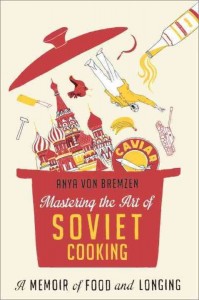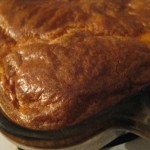 Last fall at the Brooklyn Book Festival, I wandered over to one of the stages where a panel of food writers were holding court and became instantly charmed by a woman with audacious glasses, voluminous scarves and a loud Russian-accented voice. She was just the blend of frank and weird that I like in my authors, so I resolved to read her newest book, Mastering the Art of Soviet Cooking: A Memoir of Food and Longing.
Last fall at the Brooklyn Book Festival, I wandered over to one of the stages where a panel of food writers were holding court and became instantly charmed by a woman with audacious glasses, voluminous scarves and a loud Russian-accented voice. She was just the blend of frank and weird that I like in my authors, so I resolved to read her newest book, Mastering the Art of Soviet Cooking: A Memoir of Food and Longing.
I’m so glad I did. Anya von Bremzen’s bizarre mash-up of cookbook, family history and anthropological study of Homo Sovieticus is one of the oddest but most enjoyable food volumes I’ve ever laid hands on. There is surprisingly little talk of borscht, but instead you’ll learn about Russian meat patties while also finding out how Stalin kept himself amused at his summer house meals. (It involved leaving tomatoes on chairs and exhorting high Politburo officials to put “dick” signs on Khruschev’s back. That wacky, mass-murdering prankster!) And the book is beautifully written, so much so that I laughed out loud when she described how her ex-boyfriend humbly offered himself up to co-author her first book and correct her “wonky English.”
 The USSR seemingly having been full of voracious meat-eaters whenever supplies allowed, there aren’t a lot of recipes here for a vegetarian to attempt, but von Bremzen did provide a recipe for cornbread that I was eager to try. She actually included it as something of a joke, representative of Khrushchev’s certainty that corn was going to solve all of the USSR’s food shortage problems. Instead, he managed only to baffle and disgust millions of Russians who held firmly to the belief that bread could be made only with wheat. For this, he earned the title Corn Man, which I gather sounds like a worse insult in Russian than in English.
The USSR seemingly having been full of voracious meat-eaters whenever supplies allowed, there aren’t a lot of recipes here for a vegetarian to attempt, but von Bremzen did provide a recipe for cornbread that I was eager to try. She actually included it as something of a joke, representative of Khrushchev’s certainty that corn was going to solve all of the USSR’s food shortage problems. Instead, he managed only to baffle and disgust millions of Russians who held firmly to the belief that bread could be made only with wheat. For this, he earned the title Corn Man, which I gather sounds like a worse insult in Russian than in English.
Anyway, the USSR was a massive place, and some of the people there did, in fact, eat corn, like in Moldova, whence the author drew the cornbread recipe. I was attracted to it mostly because it calls for as much feta cheese as it does cornmeal, with some butter and sour cream to boot. Continue reading
